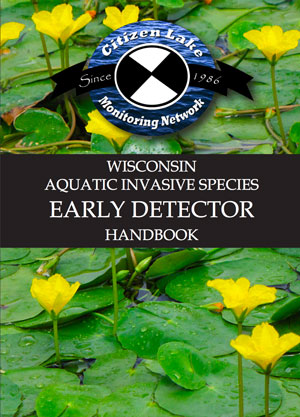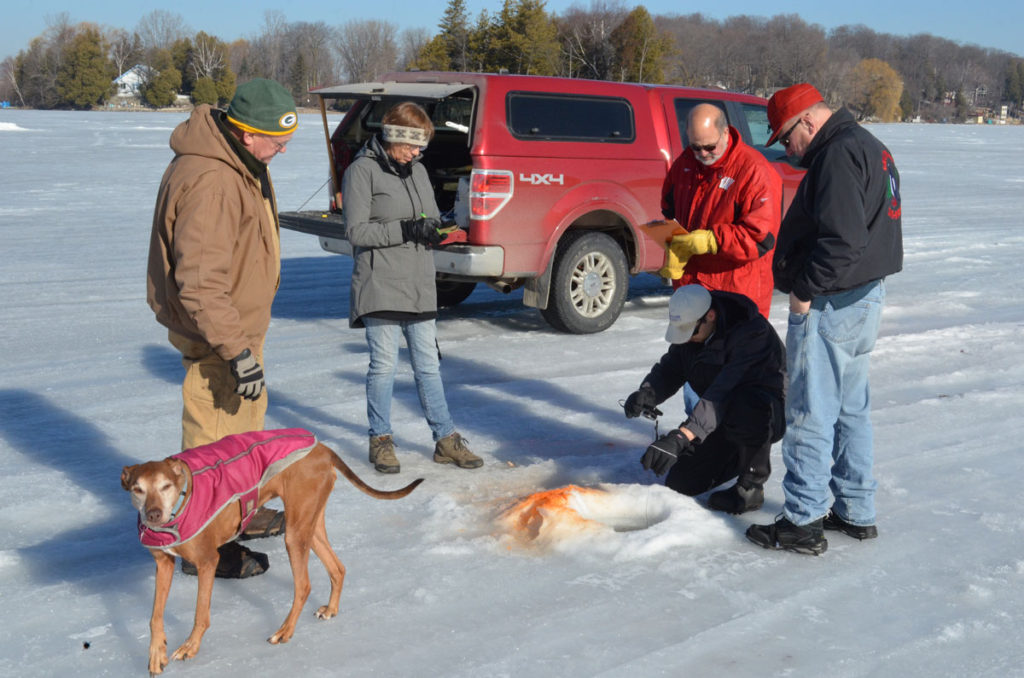by Hanna Edelglass
Have you ever wondered how sloshing around, ankle deep in water, on top of a sheet of ice, helps you to get to know your lake? We were drilling holes into the ice, angling for plants and small organisms, finding where the fish are and why they are there and each answer only brings more questions. Such as, why are these plants here? And what is their effect on the water, on fishing, on boating and swimming, property values, even the local economy? We explore and work to find out how all this relates to what flows into this lake, which can create positive or negative change, upsetting or healing its natural balance. This is the purpose of our scientific endeavor. I learnt some of that on the ice with Manitowoc County’s Cedar Lake residents and Paul Skawinski (an Aquatic Biologist and Outreach Specialist for UW-Extension) in February of this year. And yes, I wore warm, waterproof boots.
You can read a closer description of this event as well as future ones here.
Seeing changes in the lakes over time raises some hard questions: will there be time to recreate a balance, and what is needed to do so? Adaptation and rebalancing takes much time as we know from the history of past changes. If too many changes are happening too fast, then all that is healthy living and growing in your lake can be overwhelmed, can fail to adapt, and can die.
Consider: where are the boundaries of the influential zone concerning your lake? Does it end at the shoreline? At the streams that enter and leave it? The springs that feed it? The wetlands that border it? Its overall watershed area? How are we all affecting it, including the rainwater that carries what is in our air? What changes can we see with the seasons and general changes in the climate? At the recent ‘Minding Our Waters’ Wisconsin Lakes Partnership Convention in Stevens Point, Paul told me that as a child growing up in northern Illinois, he loved going fishing with his father and grandfather. Also, participating in river cleanups and building wingdams on a local stream to minimize erosion (and create good fishing spots) was an early introduction to aquatic biology. Later, when he was a college student, he inspected boats entering and leaving boat launches along Lake Michigan and Sturgeon Bay, working for The University of Wisconsin Sea Grant Institute. These experiences laid the basis for personal knowledge and a life-long curiosity. He has a B.S. in Soil Science and Waste Management, and a M.S. in Watershed Management. Paul’s current work and research are intended to provide many workable answers to the questions cited above regarding lake ecology and dynamics.
A lake is a place with objective and measurable findings. In addition to a place of beauty and tranquility, of recreation and relaxation, it is a living entity. So Paul’s experiences and learning led him in his academic career. He now teaches at UW Stevens Point and is a published author of Aquatic Plants of the Upper Midwest, a photographic field guide to our underwater forests. UW Stevens Point Bookstore
 Paul works with a wonderful group of passionate volunteers who monitor Wisconsin’s lakes. In his free time, Paul enjoys kayaking, snorkeling, photography, and spending time on lakes and streams with his family. His new Wisconsin Aquatic Invasive Species Early Detector Handbook contains concise descriptions and illustrations clarifying aquatic invasive species that threaten our waters. The handbook is available as a downloadable PDF from the UW-Extension Lakes website or as a bound booklet through their online bookstore. Here is a link for more information.
Paul works with a wonderful group of passionate volunteers who monitor Wisconsin’s lakes. In his free time, Paul enjoys kayaking, snorkeling, photography, and spending time on lakes and streams with his family. His new Wisconsin Aquatic Invasive Species Early Detector Handbook contains concise descriptions and illustrations clarifying aquatic invasive species that threaten our waters. The handbook is available as a downloadable PDF from the UW-Extension Lakes website or as a bound booklet through their online bookstore. Here is a link for more information.
For many of us, for our families, neighbors, friends and companions, the search for answers and further research was inspired when we were children. This community of common interests and abilities forms a basis for a mix of considerations of economic values, responsibility and beauty. As we have learned, sampling the life below the ice can tell you a lot about your lake. By getting to know the true size of your lake, you can contribute to its health and future.
Contact Paul Skawinski via the above websites, because we need volunteers for monitoring for what threatens your waters. Even if that may include sloshing in water on ice, with a purpose. And warm, dry boots.
— Hanna Edelglass —
Note: Paul Skawinski will return to Cedar Lake on May 30, 2017, to talk about his program. At that time, he will also be distributing AIS monitoring kits to any lake that is interested in having one (1 per lake). RSVP to Dick Jens by email or by calling 920-286-2601. We need a count for Paul. Read more here.


